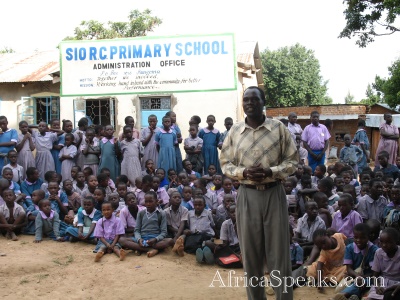The original URL of this article is:
www.africaspeaks.com/kenya/27092006.html
The Education System in Kenya
A comparison between Kenya's and Trinidad & Tobago's education systems
by Sherline O. Chase
September 27, 2006
UWI Students Trip to Kenya
 | | | Sherline O. Chase | |
Executive Summary
This report is a comparison between the primary, secondary and university undergraduate matriculation systems, in Kenya and Trinidad & Tobago. Methods of data collection include casual observation while living among Kenyans, interviews with students at the three levels and Kenyan newspaper archives. Findings show that the systems of education are similar and this similarity facilitates exchange programs at each level. However a further comparison of the two countries education curricula is recommended. There are limitations to this comparison. These limitations are: biased selection of interviewees and the fact that opinion based newspaper reports were used as a source of information.
Terms of Reference
There is a global demand for the formation of alliances between individuals, groups, institutions and nations. These alliances are the foundations of human resource sustainable development, since they are the platform for the exchange ideas. This report is not an in depth analysis but a basic comparison between the education systems in Kenya and Trinidad & Tobago. This comparison is needed to assess the possibility of future tertiary level exchange programs.
Methodology
This report was compiled after three weeks of casual observation while living among the peoples of Kenya. It was followed by online dialogue with Kenyan students at secondary and tertiary institutions and many minutes of phone discussion. Unfortunately, interaction with Kenyans was limited to Western Kenya and the institutions visited were not chosen at random. This short fall was overcome by accessing personal archives of old newspaper reports.
Introduction
Education can be defined as the development of skill, knowledge, ability and character by teaching, training, study or experience. It is not limited to a particular setting or age-group, but shapes the individual from the cradle to the grave. In this study, education refers to the window of information the government of the nation believes necessary for individuals to function as productive members of society. When education is standardized throughout the nation, all citizens have a common basic understanding. This facilitates the formation of alliances between individuals, groups and institutions.
Furthermore, if the standard of education is similar between nations, it is easier for educational institutions to build linkages for student exchange. The comparison in this report is intended to be the first step in testing the viability of tertiary level exchange programs between The University of the West Indies and universities and colleges in Kenya.
Education in Kenya
Historical Background
The system of education was introduced by British colonists. After Kenya's independence on December 12, 1963, the Ominde Commission was set up to make changes in the educational system. This commission focused on national identity and unity. Changes in the subject content of history and geography were made to reflect the building of a national identity. Between 1964 to 1985, the 7-4-2-3-system was adopted – seven years of primary, four years of lower secondary, two years of upper secondary, and three years of university. All schools had a common curriculum.
In 1981, the Presidential Working Party on the Second University was commissioned to look at both the possibilities of setting up a second university in Kenya. They were also responsible for reforming the entire education system. The committee recommended that the 7-4-2-3 system be changed to an 8-4-4 system (eight years in primary, four years in secondary, and four years in university education). Table 1.2 shows the structure of the 8-4-4 system.
Present Day Education in Kenya
The 8-4-4 system was launched in January 1985 and emphasized vocational subjects. It was assumed that this new structure would enable school dropouts at all levels to be either self-employed or to get employment in the non-formal sector.
In January 2003, the Government of Kenya announced the introduction of free primary education. As a result, primary school enrolment increased by about 70%. However, secondary and tertiary education enrollment has not increased proportionally due to the fact that payment is still required for attendance.
In class eight of primary school the Kenya Certificate of Primary Examination (K.C.P.E.) is written. The result of this examination is needed for placement at secondary school. In form four of secondary schools the Kenya Certificate of Secondary Examination (K.C.S.E.) is written. Students sit examinations in eight subjects.
KCSE Grading System
Grade A A- B+ B B- C+ C C- D+ D D- E
Points 12 11 10 9 8 7 6 5 4 3 2 1
The average grade is based on performance in the eight subjects. Where a candidate sits for more than eight subjects, the average grade is based on the best eight subjects. University matriculation is based on the best eight and performance in particular subjects relevant to degree courses.
Example below:
Subject / Group / Grade / Points
English / 1 / B+ / 10
Kiswahili / 1 / A- / 11
Mathematics / 1 / A / 12
History & Government / 3 / B / 9
Geography / 3 / A- / 11
Physics / 2 / B+ / 10
Chemistry / 2 / B- / 8
Biology 2 A- 11
The total number of points is 81.
The average grade is 81 divided by 8, which equals 10.1 (approximately 10.0 points) which is Grade B+ according to the grading system. This student qualifies to join one of the Public Universities due to his good score. Training institutions and faculties and departments determine their own minimum entry requirements.
Students who manage a grade of C+ qualify to do a degree course at the University. Due to competition, and fewer places at the University, those with B and in a few cases B-, and above are taken for degree courses at the Public Universities. The rest join private universities or middle colleges.
 | | Teacher in Sio Primary School in Kenya |
Education in Trinidad & Tobago
Historical Background
The education system in Trinidad and Tobago is based on a structure similar to the British model owing to the historical links between the two countries. After independence in 1962, Trinidad & Tobago maintained the 7-5-2-3 system of education (seven years primary, five years secondary, two years advanced secondary, three years tertiary). The importance placed on education over the past thirty years has resulted in a population almost universally literate. Census data show that the proportion of the population 15 years of age and over who reported no education declined from 11 percent in 1960 to 5 percent in 1980. The proportion attaining secondary level rose from 14 percent in 1960 to 32 percent in 1980, while the proportion attaining university education increased from less than 1 percent to 2 percent (Central Statistical Office 1987).
Present Day Education in Trinidad & Tobago
The current system maintains the 7-5-2-3 and includes the 7-5-4 or 7-5-5 time-table, depending on whether or not a student chooses to attempt A' levels. Most children are sent to pre-schools for up to two years before they enter primary school.
In Trinidad and Tobago, there is free tuition at public primary, secondary and tertiary level institutes. Entry into the free public secondary school system is gained through the Secondary Entrance Assessment (S.E.A.). In 2001 the government introduced the "placement for every student" initiative. Presently all children writing the S.E.A. examinations are placed at secondary school. The more successful schools are run by denominational boards, however most schools are well-equipped.
At the end of five years students are assessed in chosen subject areas. Mathematics and English Language are compulsory; however students need only to show their competence in three other subject areas to obtain a certificate of ordinary level secondary education. Students may then opt to pursue advanced levels.
In September 2004, Trinidad and Tobago joined its counterparts in other Caribbean islands by replacing the Cambridge Advanced Levels with the Caribbean Advanced Proficiency Examinations (C.A.P.E.). Students often apply to the University of the West Indies (U.W.I.) which has one of its three main campuses in St Augustine. There are two options for matriculation at U.W.I. Option A – Passes in five subjects of which at least two must be at the C.A.P.E./G.C.E. A' Level while the remainder may be an acceptable pass in C.X.C. examinations. Option B – An associate degree from approved Caribbean tertiary level institution with a G.P.A. of 2.5 and above. The competition to enter faculties such as Medical Sciences and Engineering is very high. Students are selected based on "the highest scorers first".
Findings & Analysis
There are four basic similarities in the systems of education in Kenya and Trinidad & Tobago. There is the similarity of classes being taught in English, especially at higher levels in the Kenyan education system. Secondly, there is the similar assessment of primary school students at the end of their primary education. The third similarity is the assessment at the end of secondary school in chosen subject areas. Another similarity is the "highest scorers first" selection criteria for students entering university. These similarities would facilitate transition from one system of learning to another.
The differences in the systems of education in Kenya and Trinidad & Tobago are essentially in the number of years spent at primary school, the number of years spent at secondary school and the absence of an advanced level examination in Kenya's System. There was no examination of the curriculum at the primary or secondary levels in both countries. Hence no comparisons of the curricula can be made at this time.
Conclusions & Recommendations
The system of education in Kenya and Trinidad & Tobago are similar enough for students at primary, secondary and tertiary levels to exchange places. While an examination and comparison of the curriculum at primary and secondary level is recommended it is not necessary to assess the viability of future exchange programs. However, an examination and comparison of the curricular of intended exchange universities is strongly advised as the development of a comprehensive exchange program depends on such a study.
References and Bibliography
Carlson 2006, hello 24 August. Email to: S. Chase
Carter, William 2006, Principal Queen's Royal College, Primary & Secondary Education in Trinidad & Tobago, interview by S. Chase, 15 August.
Emmanuel, Zirabamuzaale 2006, Hello Chase 17 July Email to: S. Chase
Emmanuel, Zirabamuzaale 2006, Questions & Answers 20 July Email to: S. Chase
Eshiwani, G.S. (1993). Education in Kenya since independence. Nairobi. EAEP
Herbling, David 2006, 'Education for all is the key to Kenya's development', The Standard, 13 March
Likoti, Mactilda 2006, Deputy Head Teacher Eshiakhondo Primary School, Primary Education in Kenya, interviewed by S. Chase, 10 July, 12 & 26 August.
Lwangu, Francis 2005, 'No difference between Kamotho and earlier education ministers', The Standard, 2 February
Malaho, Adawanga 2006, President of Kenya Volunteer Development Services, Education in Kenya, interviewed by S. Chase, 20 June.
Malaho, Esther 2006, Questions & Answers 27 July Email to: S. Chase
Fr. Marandu, Bede A Road to Inclusion: Implications of Access to Higher Education for Kenyan Women. Diss. U of Georgia, 1998.
Odour, Alfred 2005, 'You push drugs; PDE tells teachers', The Standard, 15 February
UWI Students Trip to Kenya in pictures:
http://rastafarispeaks.com/gallery/Trip_to_Africa_2006
|
|